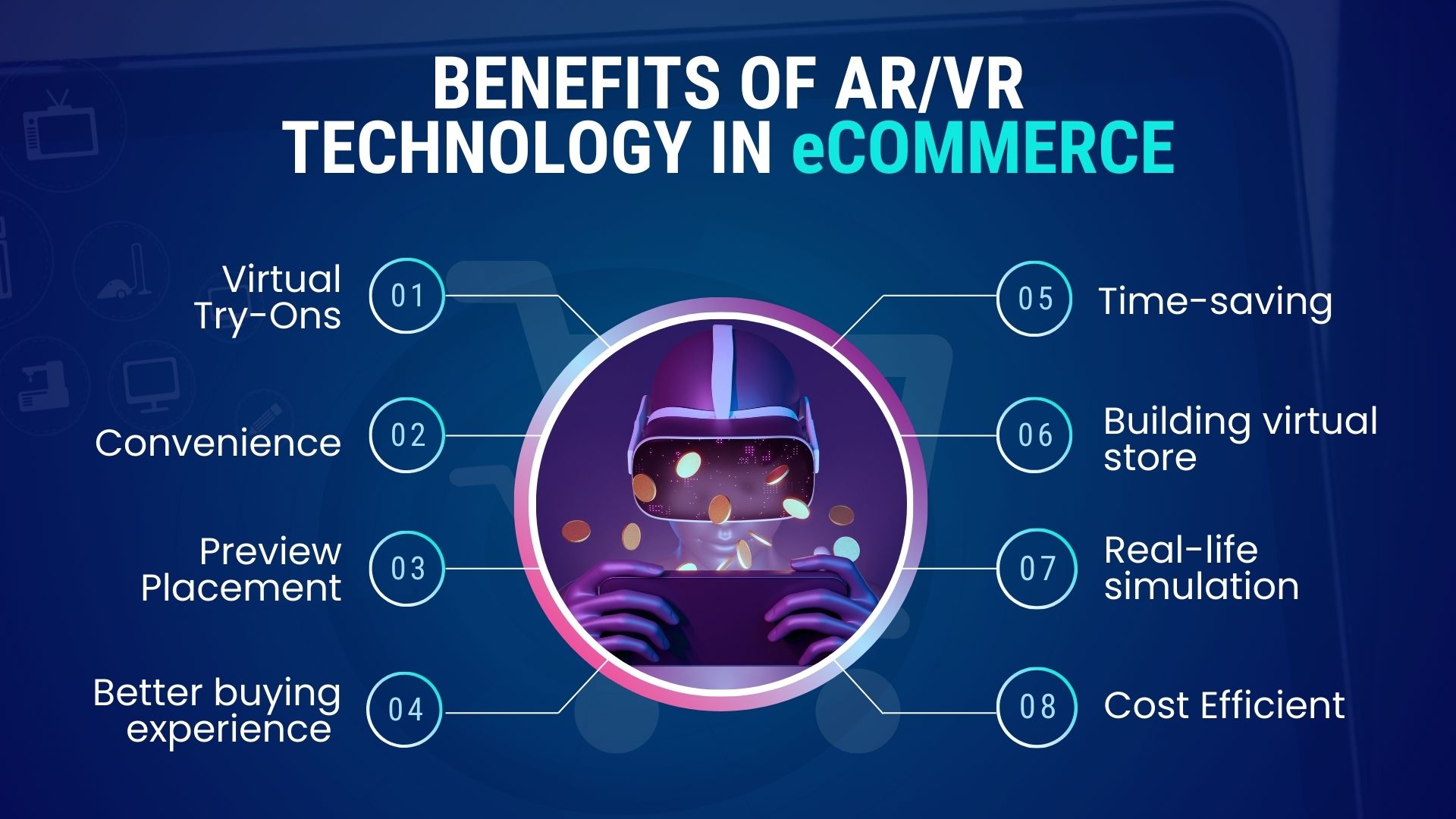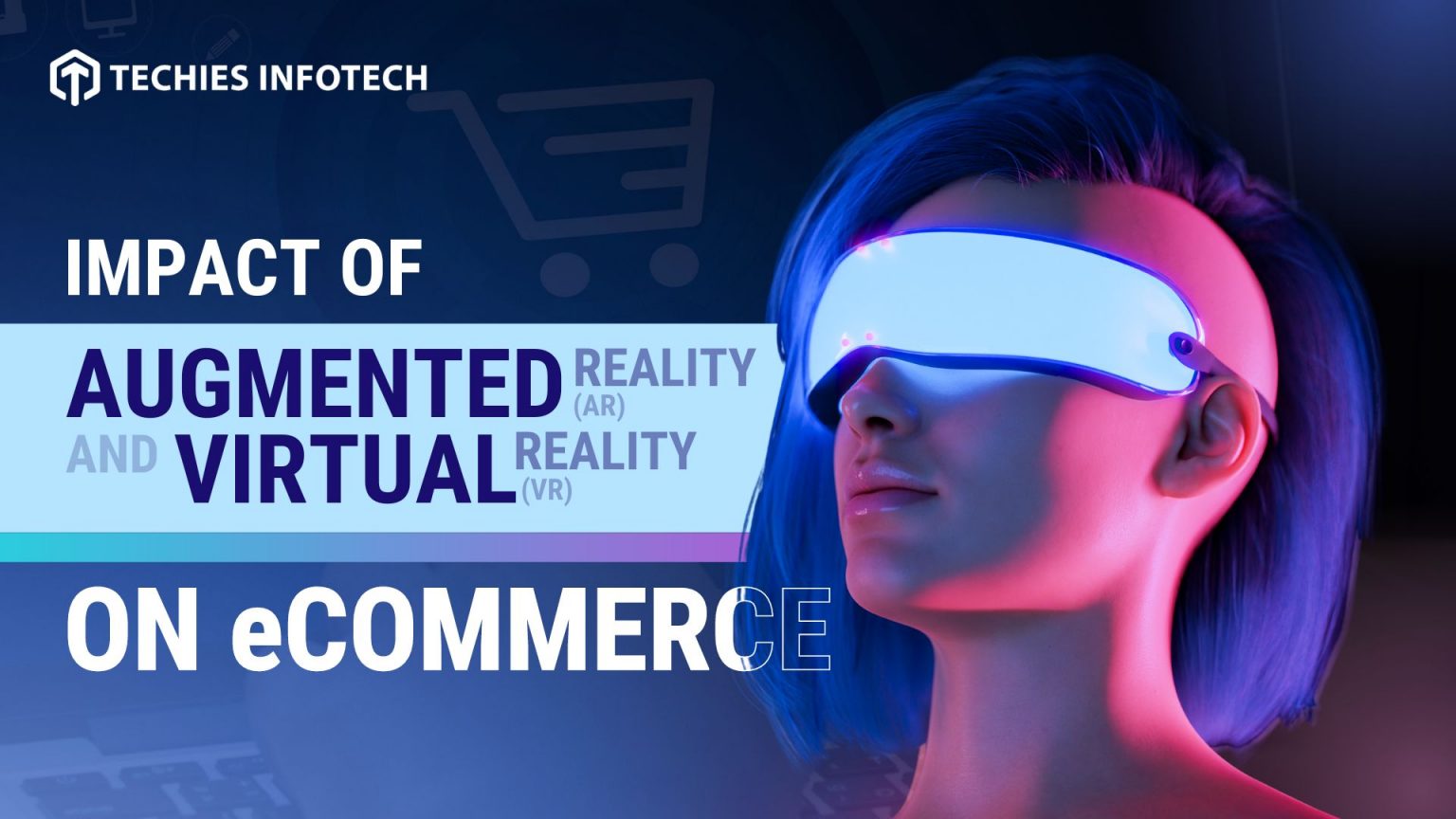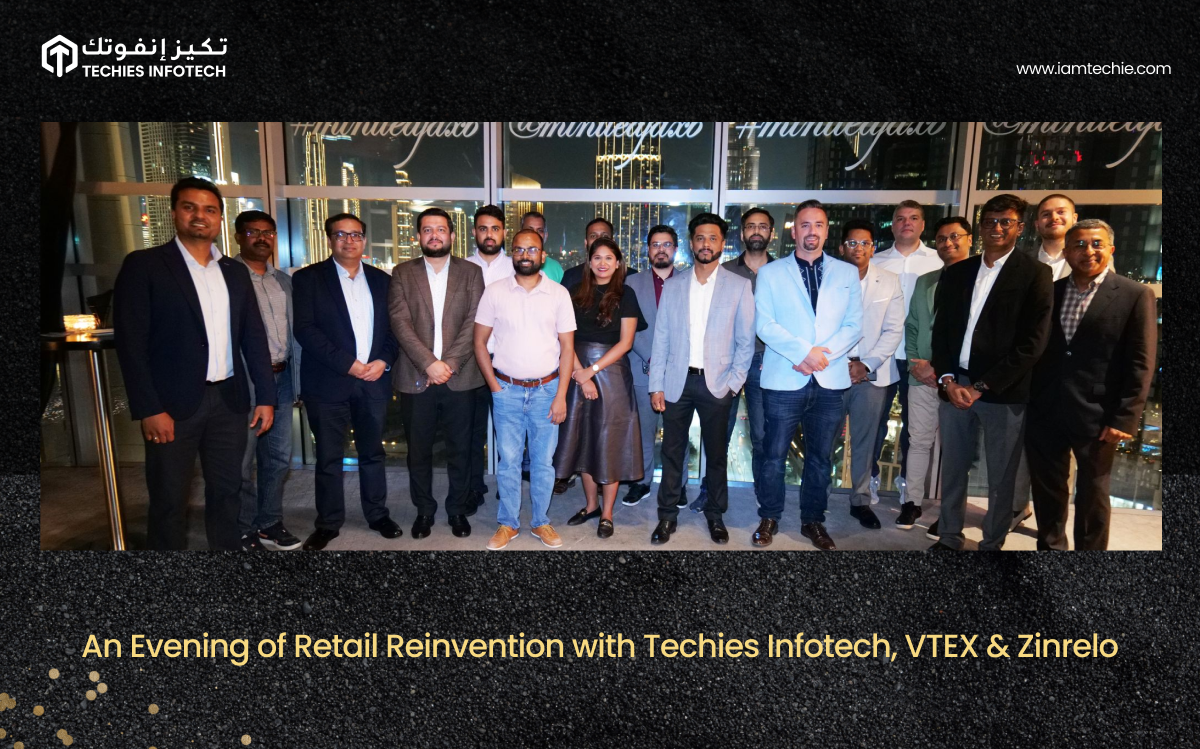Step into the realm of the future of shopping, where reality merges seamlessly with technology, and the boundaries of eCommerce are forever redefined.
Augmented Reality (AR) and Virtual Reality (VR) are not just buzzwords; they are the catalysts reshaping how we interact with products, brands, and the shopping experience. It’s a world where trying on clothes virtually, exploring virtual showrooms, and test-driving products in immersive environments are becoming the norm.
Obviously, you’re wondering what Augmented Reality (AR) and Virtual Reality (VR) are and how they can impact online shopping.
Through this blog, we will embark on a thrilling journey to explore the profound impact of AR and VR on the eCommerce landscape. We will delve into the transformative power of these cutting-edge technologies, unlocking their potential to revolutionize the way we buy and sell goods online.
So, get ready to witness a fusion of innovation and imagination where traditional online shopping meets digital enchantment.
An Introduction to AR and VR: Understanding the Basics
Augmented Reality (AR) and Virtual Reality (VR) are groundbreaking technologies that have revolutionized the way we interact with the digital world. They offer immersive and interactive experiences that seamlessly blend the virtual and real worlds, enhancing various industries from entertainment to education.
AR is the integration of digital content into the real environment, superimposing computer-generated elements onto the user’s view of the physical world. This technology is often experienced through smartphones or AR glasses, allowing users to interact with virtual objects in real time.
On the other hand, VR creates a fully simulated environment that users can immerse themselves in using specialized VR headsets. The technology isolates users from the real world and transports them into a completely virtual environment, giving them a sense of presence and interaction with their surroundings.
Both AR and VR rely on sophisticated software and hardware to deliver captivating experiences. AR uses computer vision and sensors to recognize and map the real environment, while VR requires powerful processors and display screens to create realistic virtual worlds.
AR and VR in eCommerce
In the dynamic world of eCommerce, Augmented Reality (AR) and Virtual Reality (VR) are emerging as game-changers, transforming the way customers shop online. The following numbers behind this integration reveal its tremendous potential to boost sales, increase customer engagement, and revolutionize our online shopping.
“The Virtual Reality and Augmented Reality market in the Retail industry was estimated to have a worth of $3.79 billion in 2021, which is expected to increase to $17.86 billion by 2028.” (Source: emizentech)
“North America accounted for the maximum share of AR/VR use in eCommerce with 42.4%.” (Source: GlobeNewswire)
“According to a consumer survey conducted by Google, it was found that more than 66% of users would like to use AR technology for a better shopping experience.” (Source: Reydar)
Benefits of AR/VR Technology in eCommerce

AR/VR technologies offer a plethora of benefits to the eCommerce industry, transforming the way customers shop online and enhancing their overall buying experience.
- Virtual Try-ons: AR allows customers to virtually try on products like clothing, accessories, and even makeup, giving them a realistic preview of how the items will look on them before making a purchase. This feature reduces the uncertainty of online shopping and increases customer confidence in their choices.
- Better Buying Experience: By providing immersive and interactive experiences, AR/VR technologies make buying more enjoyable and engaging for customers. They can explore products from different angles, zoom in on details, and make informed decisions, leading to higher customer satisfaction.
- Convenience: With AR/VR, customers can shop from the comfort of their homes, eliminating the need to visit physical stores. This convenience is especially beneficial for customers with mobility constraints or those living in remote areas.
- Time-saving: AR/VR technologies streamline shopping, enabling customers to visualize and assess products quickly. They no longer need to spend time visiting multiple stores physically, resulting in a more efficient shopping experience.
- Cost-efficient: Virtual try-ons and simulations reduce the need for physical prototypes and samples, reducing business production costs. Additionally, customers can avoid purchasing products that may not suit them, leading to fewer returns and exchanges.
- Real-life Simulation: AR/VR technologies provide customers with a realistic simulation of how products will appear in their physical space. For example, customers can visualize how furniture will fit in their homes or how a new paint color will look on their walls.
- Building Virtual Stores: Brands can create virtual stores or showrooms where customers can navigate and explore products just like in a physical store. This innovative approach enhances the shopping experience and helps businesses stand out in a competitive market.
- Preview Placement: AR allows customers to place products virtually in their surroundings, such as furniture in their living room or artwork on their walls. This functionality enables customers to assess the compatibility and aesthetics of the products before making a purchase decision.
Incorporating AR/VR technologies in eCommerce benefits customers and drives business growth. By leveraging these advanced tools, eCommerce businesses can provide personalized, convenient, and engaging shopping experiences that set them apart from competitors, ultimately leading to increased sales and customer loyalty.
Real-Time Implementation of AR/VR in eCommerce
In the ever-evolving world of eCommerce, immersive technologies such as Augmented Reality (AR) and Virtual Reality (VR) are revolutionizing the way customers interact with products, brands, and the entire shopping process. Following are some of the examples of real-time implementations:
-
IKEA:
IKEA, the Swedish furniture giant, has been at the forefront of AR implementation in eCommerce. With their “IKEA Place” app, customers can virtually place furniture in their homes to see how it fits and complements their existing decor. The app scales and positions furniture with incredible accuracy using augmented reality, allowing users to make informed purchase decisions. This real-time AR experience has not only enhanced customer satisfaction but also reduced the return rate, revolutionizing furniture eCommerce.
-
Lenskart:
Lenskart, a leading online eyewear retailer, has leveraged augmented reality to revolutionize the way customers shop for glasses. Their “3D Try On” feature allows users to virtually try on different frames, enabling them to see how the glasses look on their faces in real-time. By integrating AR into their platform, Lenskart has significantly improved the online shopping experience for customers, making it easier to find the perfect pair of glasses that suit their style and facial features.
-
BMW Augmented Reality:
BMW has embraced augmented reality to enhance the car buying process for customers. Prospective buyers can explore and customize BMW models in real time with their AR app. From changing the car’s color to visualizing different interior options, this immersive AR experience empowers customers to configure their dream car virtually. BMW’s implementation of AR has increased customer engagement and streamlined the decision-making process, making it an innovative tool in the automotive eCommerce sector.
-
Amazon Augmented Reality:
As one of the world’s largest eCommerce platforms, Amazon has ventured into the AR space to elevate the shopping experience for customers. Through their “AR View” feature on the Amazon app, customers can visualize how various products, such as furniture and home decor items, will look in their homes before making a purchase. This real-time AR implementation has added value to Amazon’s eCommerce ecosystem, giving customers greater confidence in their buying decisions.
-
Sephora Virtual Assistant:
Sephora, the renowned beauty retailer, has embraced virtual reality to transform the way customers interact with their products. With their “Sephora Virtual Artist,” users can virtually try on makeup products, experiment with different looks, and receive personalized beauty recommendations. This virtual assistant offers an immersive shopping experience and provides valuable insights to customers, ensuring they make the most suitable beauty choices.
-
Lakme Virtual Try-On:
Lakme, a popular cosmetics brand, has integrated virtual try-on technology into its platform, allowing customers to experiment with different makeup products virtually. Using smartphones or computers, users can virtually apply shades of lipstick, eyeshadow, and more in real-time. This AR implementation has empowered Lakme’s customers to confidently explore and discover new products, ultimately enhancing customer engagement and brand loyalty.
These real-time implementations of AR/VR in eCommerce have transformed the way customers shop for products, bringing immersive and interactive experiences to the digital realm. As technology continues to advance, we can expect even more exciting developments in the AR/VR space, further blurring the lines between the physical and digital shopping experiences.
How AR/VR can Help Your Businesses To Grow?
The integration of AR/VR into your business can have a transformative impact on various aspects, some of which are briefly explained below:
Enhanced Customer Engagement:
AR and VR technologies create captivating and interactive experiences for customers, encouraging them to spend more time on your website or app. Engaging content drives customer interest and promotes brand loyalty, ultimately leading to increased sales and repeat business.
Improved Product Visualization:
AR allows customers to visualize products in their real-world environment, enabling them to assess size, fit, and compatibility. VR takes this a step further by immersing customers in a virtual experience, giving them a comprehensive understanding of the product’s features and benefits. This enhanced visualization leads to confident purchasing decisions and reduces the likelihood of returns.
Personalized Shopping Experiences:
By gathering customer data, AR/VR can offer personalized recommendations and tailor the shopping journey to individual preferences. Providing a customized experience makes customers feel valued, boosting their satisfaction and encouraging them to return for future purchases.
Reduced Showrooming:
AR/VR experiences provide customers with a virtual try-on or test drive, which reduces the need for physical showrooms. This saves operational costs and creates a seamless shopping experience, allowing customers to explore products from the comfort of their homes.
Enhanced Marketing and Branding:
AR/VR campaigns create a buzz around your brand, setting your business apart from competitors. Interactive marketing experiences generate social media shares and word-of-mouth promotion, expanding your reach and attracting new customers.
Streamlined Training and Onboarding:
Incorporating AR/VR into employee training and onboarding processes enhances efficiency and effectiveness. Employees can receive immersive training experiences, leading to quicker skill development and reduced training costs.
Remote Collaboration and Communication:
AR/VR facilitates remote collaboration, allowing teams to work together regardless of their physical locations. Virtual meetings, presentations, and product development sessions become seamless, promoting productivity and saving time and travel expenses.
Virtual Prototyping and Product Development:
AR/VR technologies enable businesses to create virtual prototypes and simulations, streamlining the product development process. This leads to faster iterations and cost-effective enhancements before moving to physical production.
Data-driven Insights:
AR/VR implementations can gather valuable data on customer behavior, preferences, and interactions with products. Analyzing this data provides businesses with actionable insights, enabling them to make informed decisions for future improvements.
Differentiation and Innovation:
Embracing AR/VR showcases your business as an innovative and customer-centric brand, setting you apart from competitors. Early adoption of these technologies demonstrates your commitment to enhancing the customer experience and staying at the forefront of industry advancements.
Final Thoughts!
The future of shopping is indeed bright, as AR and VR pave the way for a more immersive, interactive, and personalized eCommerce landscape. As technology continues to evolve, we can expect even more exciting advancements that will further shape the way we buy and sell products, ensuring that the shopping experience remains an enchanting and unforgettable journey.
Frequently Asked Questions
Q. How does Augmented Reality (AR) and Virtual Reality (VR) impact eCommerce?
AR and VR have a profound impact on eCommerce by enhancing customer experiences. They enable interactive product visualization, personalized shopping, and immersive engagement, leading to increased customer satisfaction and loyalty. These technologies bridge the gap between physical and online shopping, transforming the way customers interact with products and brands.
Q. What potential benefits do retailers gain from using augmented reality or virtual reality technology within their business operations?
Retailers gain several benefits from using AR and VR. These technologies improve customer engagement, reduce product returns, and enhance brand differentiation. AR/VR also streamlines product development, employee training, and remote collaboration, leading to increased efficiency and cost savings. Ultimately, retailers can build stronger customer relationships, increase sales, and stay ahead of competitors.
Q. How is the delivery of products impacted by the use of AR/VR technology within eCommerce platforms?
AR/VR technology improves the delivery process by enhancing customer satisfaction and reducing the likelihood of returns. Virtual try-on and product visualizations help customers make confident purchasing decisions, ensuring they receive products that meet their expectations. This leads to smoother post-purchase experiences and a more positive perception of the retailer’s delivery process.
Q. To what extent does integrating Augmented /Virtual Reality onto my website benefit me financially?
Integrating AR/VR onto your website can provide significant financial benefits. Enhanced customer experiences lead to higher customer retention, repeat business, and increased word-of-mouth referrals. Reducing product returns through virtual try-ons also saves costs associated with restocking and shipping. Additionally, the differentiation and innovative image gained from using AR/VR can attract new customers and contribute to revenue growth.












